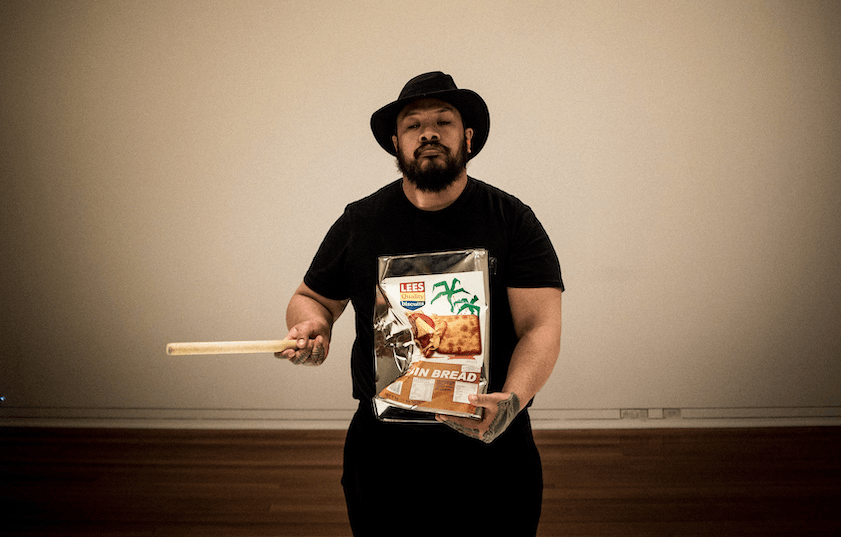Tongan New Zealand performance artist Kaisolaite Uhila is the current visiting artist in residence at Dunedin Public Art Gallery. Whether he’s living homeless around the boundary of Auckland Art Gallery for the Walters Prize, or sleeping with pigs in Aotea Square, Uhila uses his body and its labour to start uneasy conversations that break down barriers between art and life, and the gallery and the community that surrounds it.
In his new work Kapa Mā, Uhila is using the Dunedin gallery as an open studio, a space to develop new ideas and to perform – including a daily drumming session that’s gradually doing damage to a pallet’s worth of cabin bread. Photographers Robert George and Justin Spiers captured Uhila’s residency, and I spoke to him in the gallery.
A pallet of 70 cabin bread tins. Three months. What’s the process?
I come in, drumming on one or two tins, creating works from these large tins of cabin bread. These tins gradually start to bear the marks of these performances. The surfaces and the form of the object record my performances as sculptures.
I don’t have a set time to start or finish every day. I might come in at one o’clock and stay here till five o’clock. I also have the tins as sculptures, so people can come in without me being in the space. Or if they see me in the space we can talk. There’s participation as part of the work – they get to drum as well. I’m drumming, I’m utilising the space, I’m just being present.
Why cabin bread (or, as it’s sometimes called, ship’s biscuit)?
It’s a common food item in homes throughout the Pacific. I grew up eating cabin bread. It’s good. One tin can feed a family. It’s a childhood memory that after eating the cabin bread, the tin became improvised as a drum set.
The tins came with the bread in them. I’ve got some at home here in Dunedin that I eat, the family keeps it, and I’ve also been sharing it out.
Is it hard to beat those tins into shapes?
It’s real soft. Aluminium. When I get into it I get into a rhythm. Each will usually take half an hour to an hour.
Your work often brings together the body, sound, form and memory. Are you paying the most attention to the sound you’re making, or the sculpture you’re forming?
That’s a good question. I’ve been thinking about that. I have this theory that its like the sound makes the mark, and the mark makes the sound. I wouldn’t put an answer to it. It’s more about the process. I kind of get into a zone with it. It’s only at the end you realise there’s someone else in the room.
Do they make a good sound?
Yes! I’ll give you a little bit of a beat!
That’s a great sound! Sounds really therapeutic giving that a bash.
Yeah, that’s what the public say. You kind of go into a drift with it.
I’m reminded of artist Michel Tuffery’s use of corned beef tins in sculpture and performance.
Yes, Michel Tuffery is an influence on my practice. I would also reference here pop art. Andy Warhol. And Marcel Duchamp, with the readymade.
These performance images Justin Spiers took at the opening – who do we see?
They’re a group of young Pacific Island artists and musicians from the community. I asked them to collaborate with me – to connect with the local Pacific people living down in Dunedin. I met these young people of talent. The group is called Le Apatonga.
Many of your performances are outside the gallery’s white walls. Here you seem to embrace that framing: sculpture meets performance; bright lights bounce off the metal tins.
Yes. I chose the actual inside of the gallery because there’s an aspect of safety, and I liked the idea of bringing people into the gallery. It’s that idea of the outside being connected to the inside. And the gallery also frames the work.
Most of your performance is undertaken alone over long periods of endurance.
Yes, yes. It’s a time-based work. Gradually the platform will be filled with tins. Kind of look like tombstones.
Tombstones?
It’s kind of feeling like that, yeah.
In terms of your life: both your family and your work. Is the boundary between the two always easy to maintain?
I’ve got my family with me in Dunedin. It can be hard at times. I have the support and acceptance of my wife. She allows me to do what I do. She’s the backbone. You know what it’s like, Mark! The backbone of what we do and that.
To keep sharp for performances the first thing to do is ensure my family are all set. Once the kids are at school I have my time in the gallery. That’s why I don’t have a timeframe for when I will be at the gallery. I keep it open.
Congratulations on being selected for Sydney Biennale next year. What have you got planned?
Well, just at this moment I’m looking at a box of nails… Nah, nah! Don’t have anything planned at the moment! I’ve got a few ideas around the edge. Just right now I’m just looking at a box of nails. So that’s what comes to mind. You never know…
